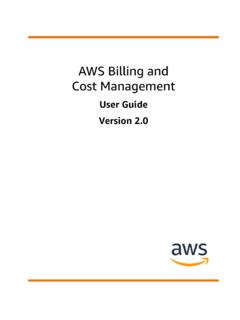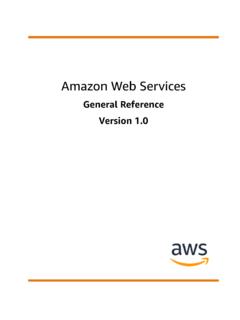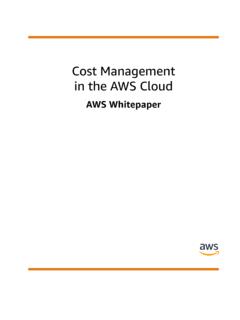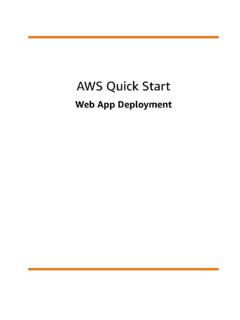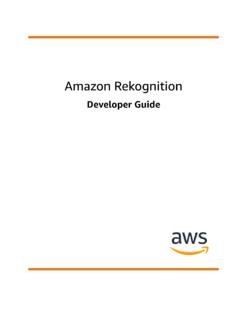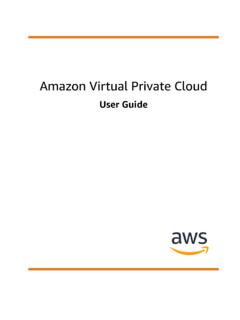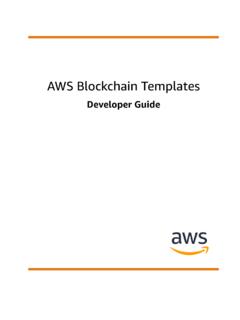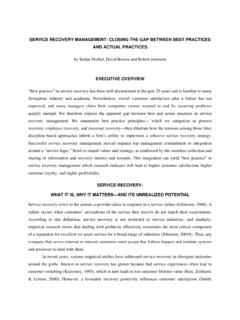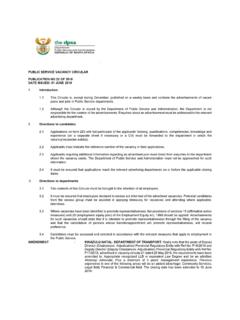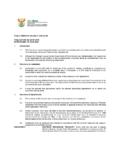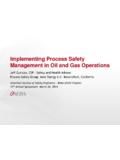Transcription of Best Practices for Running Oracle Database on …
1 Best Practices for RunningOracle Database onAmazon Web ServicesAWS WhitepaperBest Practices for Running Oracle Databaseon Amazon Web Services AWS WhitepaperBest Practices for Running Oracle Database on Amazon Web Services:AWS WhitepaperCopyright 2019 Amazon Web Services, Inc. and/or its affiliates. All rights 's trademarks and trade dress may not be used in connection with any product or service that is not Amazon's, in any mannerthat is likely to cause confusion among customers, or in any manner that disparages or discredits Amazon. All other trademarks notowned by Amazon are the property of their respective owners, who may or may not be affiliated with, connected to, or sponsored Practices for Running Oracle Databaseon Amazon Web Services AWS WhitepaperTable of ContentsBest Practices for Running Oracle Database on Amazon Web Services.
2 1 Abstract .. 1 Introduction .. 1 Oracle Licensing Considerations .. 3 Amazon RDS License Included .. 3 Bring Your Own License (BYOL) .. 4 Oracle License Portability to AWS .. 4 Choosing Between Amazon RDS and Amazon EC2 for Your Oracle Database .. 5 Architecting for Security and Performance .. 6 Network Configuration .. 6 Amazon EC2 Instnace Type .. 7 Database 8 Backup 9 Amazon S3 .. 10 Amazon EFS .. 10 Amazon EBS Snapshots .. 11 Oracle on 11 AWS Systems Manager .. 12 Resources .. 13 Document 14 Document History .. 14 AWS Glossary .. 15iiiBest Practices for Running Oracle Databaseon Amazon Web Services AWS WhitepaperAbstractBest Practices for Running OracleDatabase on Amazon Web ServicesPublication date: January 2018 (Document Details (p.))
3 14))AbstractAmazon Web Services (AWS) offers you the ability to run your Oracle Database in a cloud Oracle Database in the AWS Cloud is very similar to Running Oracle Database in yourdata center. To a Database administrator or developer, there are no differences between the twoenvironments. However, there are a number of AWS platform considerations relating to security, storage,compute configurations, management, and monitoring that will help you get the best out of yourOracle Database implementation on AWS. This whitepaper provides best Practices for achieving optimalperformance, availability, and reliability, and lowering the total cost of ownership (TCO) while runningOracle Database on AWS.
4 The target audience for this whitepaper includes Database administrators,enterprise architects, systems administrators, and developers who would like to run their OracleDatabase on Web Services (AWS) provides a comprehensive set of services and tools for deploying OracleDatabase on the reliable and secure AWS Cloud infrastructure. AWS offers its customers two options forrunning Oracle Database on AWS: Using Amazon Relational Database Service (Amazon RDS) for Oracle , which is a managed databaseservice that helps simplify the provisioning and management of Oracle databases. Amazon RDS makesit easy to set up, operate, and scale a relational Database in the cloud by automating installation, diskprovisioning and management, patching, minor version upgrades, failed instance replacement, as wellas backup and recovery Multi-AZ feature of Amazon RDS operates two databases in multiple Availability Zones withsynchronous replication, thus creating a highly available environment with automatic failover.
5 Thepush-button scaling feature of Amazon RDS allows you to easily scale the Database instance up ordown for better cost management and performance. Amazon RDS also comes with a License Includedservice model, which allows you to pay per use by the hour. Running a self-managed Oracle Database directly on Amazon Elastic Compute Cloud (Amazon EC2).This option gives you full control over the setup of the infrastructure and Database the Database on Amazon EC2 is very similar to Running the Database on your own server. Youhave full control of the Database and have operating system-level access, so you can run monitoringand management agents and use your choice of tools for data replication, backup, and , you have the ability to use every optional module available in Oracle Database .
6 However,this option requires you to set up, configure, manage, and tune all the components, including AmazonEC2 instances, storage volumes, scalability, networking, and security, based on AWS architecture bestpractices. In the fully managed Amazon RDS service, this is all taken care of for you choose to run a self-managed Oracle Database on Amazon EC2 or the fully managedAmazon RDS for Oracle , following the best Practices discussed in this whitepaper will help you get1 Best Practices for Running Oracle Databaseon Amazon Web Services AWS WhitepaperIntroductionthe most out of your Oracle Database implementation on AWS.
7 We ll discuss Oracle licensing options,considerations for choosing Amazon EC2 or Amazon RDS for your Oracle Database implementation, andhow to optimize network configuration, instance type, and Database storage in your Practices for Running Oracle Databaseon Amazon Web Services AWS WhitepaperAmazon RDS License IncludedOracle Licensing ConsiderationsOracle Database licensing on AWS is based on the size of the instance on which the Database is information about Oracle Database licensing, see Licensing Oracle Software in the Cloud ComputingEnvironment on the Oracle website. A few key points to consider are: As stated in Amazon EC2 Instance Types page, each vCPU is a hyperthread of an Intel Xeon core exceptfor T2 and For Oracle Enterprise Edition every two vCPUs of hyperthreaded instanceequate to a licensing requirement of one Oracle processor license.
8 For non-hyperthreaded instances,each vCPU equate to one Oracle processor license. Oracle Database Standard Edition may only be licensed on instances that have up to 16 AmazonvCPUs. Oracle Standard Edition One and Standard Edition Two may only be licensed on instances up to 8 Amazon vCPUs. For Oracle Database Standard Edition, Standard Edition One, or Standard Edition Two, every fourAmazon vCPUs used (rounded up to the nearest multiple of four) equate to a licensing requirement ofone socket, which is considered equivalent to an Oracle processor discussion of Oracle licensing policies and costs in this whitepaper is for informational purposes onlyand is based on the information available at the time of publication.
9 For more specific information, usersshould consult their own Oracle license RDS License IncludedYou have the option to include the cost of the Oracle Database license in the hourly price of the AmazonRDS service if you use the License Included service model. In this case, you do not need to purchaseOracle licenses separately; the Oracle Database software has been licensed by AWS. License Includedper-hour pricing includes software, underlying hardware resources, and Amazon RDS managementcapabilities. This service model optimizes license costs, and gives you flexibility when scaling yourAmazon RDS instances up or down.
10 You can take advantage of hourly pricing with no upfront fees orlong-term commitments. In addition, you can purchase Amazon RDS Reserved Instances under one-yearor three-year reservation terms. With Reserved Instances, you can make a low, one-time payment upfront for each Database instance, and then pay a significantly discounted hourly usage hourly license for the License Included model in Amazon RDS is available only for OracleStandard Edition One and Standard Edition Two. For other editions of Oracle Database onAmazon RDS and any edition of Oracle Database on Amazon EC2, you need to use your ownlicense (that is, acquire a license from Oracle ), as discussed in the following you are paying for the Oracle license only for the hours in which you use Amazon RDS, the LicenseIncluded option may help you reduce overall licensing costs for development and testing environmentsthat are active only during business hours.
